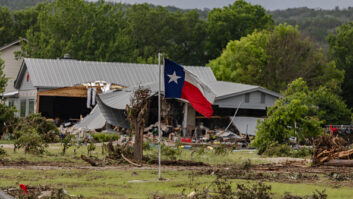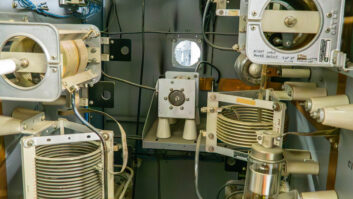
MONZA, Italy — In 1929, state-owned Ente Italiano per le Audizioni Radiofoniche, the Italian Body for Radio Broadcasting, established its broadcasting control center in Sesto Calende, near Lake Maggiore. The center monitored the frequency occupation on the entire spectrum of medium wave and shortwave bands on a daily basis.
After World War II, EIAR became RAI, Radio Televisione Italiana and in the early 1950s, the rise of FM radio and TV broadcasting in Italy required the control center to develop specific infrastructures to also monitor these frequencies.

A technician carries out RF measurements at Rai Way’s
Monza facilities around 1960.
NO MAN-MADE NOISE
In 1954 the control center moved to Monza, within a Natural Park, and far enough away from any man-made noise capable of affecting radio reception. In 2000, RAI spun off its former broadcasting division and renamed it Rai Way, which presently operates as the network provider for RAI.
The former control center in Monza is now the headquarters of Rai Way’s Innovazione, Certificazione e Sperimentazione Radioelettrica (Radio Frequency Innovation, Certification and Field Testing) department.
RAI has long run a comprehensive remote control and management system to operate its transmitting sites, explains Aldo Scotti, head of ICSR at Rai Way. ”In the late 1990s, we envisioned the possibility of designing and operating a field monitoring network for benchmarking purposes.”
This monitoring network was not intended for everyday operational purposes. The idea was to develop a network of monitoring stations within the service area of Rai Way’s transmitters that was able to carry out statistical analysis on the performance of Rai Way’s broadcast networks, along with that of competing networks.
“We had the opportunity to start from scratch, so we could really develop and tailor the best solution to comply with the project’s goals,” Scotti said. “The monitoring network had to be accurate, reliable, fully remote-controllable and budget-minded.”
The new monitoring network was named “Rete Leggera” (“Light Network”). A major requirement for these monitoring stations was their capability to be positioned almost anywhere, so they needed to be light and simple.

Aldo Scotti is head of ICSR at Rai Way.
“This compelled us to move the computational power elsewhere,” Scotti explained. The Rete Leggera design features three physical layers: monitoring stations (detectors, Layer III), network nodes (Layer II) and network management (Layer I).
Each monitoring station includes professional-grade receiving antennas and combiners, one or more measurement device per each broadcast standard (MW, FM, DAB+, DTT) and a local controller. Rai Way’s technicians custom-designed and built the controller.
“Targeting 100 percent availability, we carefully selected a specific IT-based fanless appliance where we installed just two pieces of software — a basic OS and a proprietary package we created to manage the operational cycle of the various receivers and communication to the node level,” he said.
TIME MACHINE
Depending on the location of the monitoring station, the controller adjusts each receiver to tune into a frequency from an assigned list, on a round-robin basis, then perform the required measurements, according to a specific time window.
“We monitor the performance of our networks, and also of our competitors, as well as checking for possible interference from abroad [North Africa, the Balkins, etc.].” Each controller stores the resulting data from the various measurements for five minutes, then forwards a message including all the acquired data to its hierarchical network node (Layer II), in a proprietary and “lite” format to limit the bandwidth requirement and the amount of data transfer.

Statistics from Rai Way’s “Rete Leggera” regarding broadcasts
from the Roma Monte Mario transmitting site in Rome.
A specific message allows each network node to acknowledge proper message reception. When the sending controller receives confirmation, it deletes the measurement records. “We chose to implement local controllers with virtually no local storage, to keep them simple and to speed up each data transmission,” Scotti added.
Rete Leggera controllers are connected to the network nodes (Layer II) via a proprietary VPN. Each network node compares every measurement set with specific thresholds, with the corresponding previous set and with the resulting mid-term trend from the same monitoring station. The node subsequently deletes the data situated within the relevant limits, while it stores each measurement records not matching with the expected figures.
The nodes also build graphics for each monitored value at any measurement station. If nothing “out-of-spec” is registered within 24 hours, each node stores one measurement set per day from each monitoring station.
“The network nodes store data corresponding to a specific moment when something went out of the expected figure at a specific location,” said Scotti. “Rete Leggera is a sort of time machine capable of reverting us to the very moment when something happened.”
KEY PERFORMANCE
On a daily basis, each network node forwards the recorded events to the network management (Layer I) of Rete Leggera. Network nodes generate alarms and triggers as the consequence of a detected status change of the monitored parameters. The network management aggregates all the data from the entire territory and maps each measurement event to a specific transmitter and to a specific service.
Even if broadcasts from a given transmitter are clearly receivable in one measurement location, interference or other impairments can affect the quality of service for the same broadcast at a different location.
Rete Leggera’s advanced graphic interface provides mid- and high-level managers with key performance indicators on the entire broadcasting network. Any kind of drill-down is then allowed. Operators can compare the performance of a specific Rai Way service versus the performance of a different service, either from Rai Way or its competitors.

A map of Italy showing status of Rai Way’s “Rete Leggera monitoring stations. The image highlights two event notifications in red.
Rete Leggera can produce historical reports for both nationwide or regional services, as well as for a given transmitter. Transmitting sites with similar equipment but different configuration can be compared from the point of view of their reliability and overall availability. The same applies to nominally identical transmitting sites that are using equipment from different manufacturers.
Today, the Rete Leggera network comprises 50 monitoring stations, covering about 70 percent of the potential nationwide audience. Rai Way intends to deploy 10 additional monitoring stations in the future.







